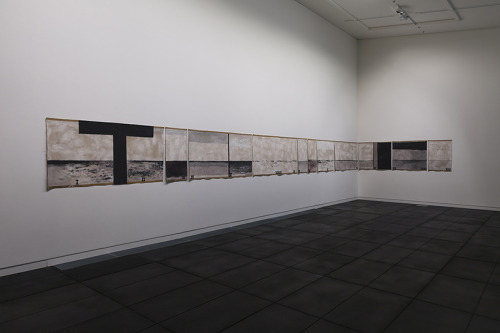Art vocab to impress your friends
by Eleanor Lee-Duncan
Chiaroscuro “key-are-oh-skur-oh”
‘(Ital. light-dark). As generally used, chiaroscuro (or the French clair-obscur) means the balance of light and shadow in a picture, and the skill shown by the painter in the management of shadows.’
-The Penguin Dictionary of Art and Artists
In other words, when we look at an image, whether a painting, photograph, film still, drawing, or engraving and can clearly see an interplay between areas of light and darkness, we are looking at chiaroscuro. This can be used as soft, smoky blended areas to create a sense of subtle three-dimensionality, or it can be used boldly in clear, crisp areas of light and shadow which contrast within an image to create a sense of dynamism or drama. Sometimes chiaroscuro is used to highlight or bring attention to a certain area or aspect of a work.
The current exhibition at the Adam Art Gallery, called The Specious Present, is fairly monochromatic: most artists limit themselves to shades of white and black in the works displayed.

Image credit: Adam Art Gallery
For example, in this work by Colin McCahon, currently on display at the Adam Art Gallery, titled Walk (Series C), we can see that McCahon has used different gradients of painted shade in each strip of canvas. In the first panel on the left, McCahon has used chiaroscuro to create a jet black, vivid ‘T’ shaped cross, which cuts down through the entire composition with force. The ‘T’ stands out especially because the horizon line which intersects it is lighter as it gets closer on either side. Because of this, the lower half of the ‘T’ seems to stand out more – this is because the fading horizon line behind it emphasizes it, and seems to push the ‘T’ towards us.

Image credit: caravaggio.org
In a more traditional sense, chiaroscuro is used in art history to refer to this interplay between light and shadow especially in Baroque art, for example in Caravaggio’s paintings. Like his painting above, Judith beheading Holofernes, Caravaggio uses chiaroscuro as a strong compositional device. He has used bright, harsh light on the three figures which contrasts with dark areas, defining the muscular contortions of Holofernes as he dies. Judith in the centre seems to radiate with this light, which illuminates her face and collar. Also, you can see that the shadows in the background are incredibly dark, making the figures appear like spot lit actors frozen in a film noir scene.
No comments:
Post a Comment